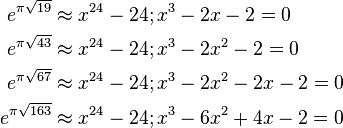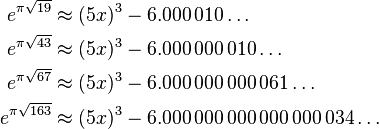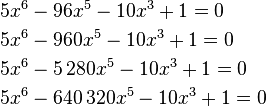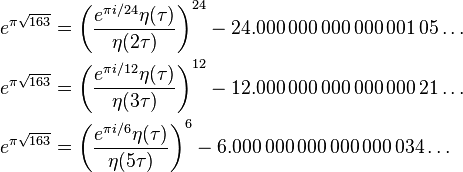Heegner number
In number theory, a Heegner number is a square-free positive integer d such that the imaginary quadratic field Q(√−d) has class number 1. Equivalently, its ring of integers has unique factorization.[1]
The determination of such numbers is a special case of the class number problem, and they underlie several striking results in number theory.
According to the Stark–Heegner theorem there are precisely nine Heegner numbers:
This result was conjectured by Gauss and proven by Kurt Heegner in 1952.
Euler's prime-generating polynomial
Euler's prime-generating polynomial
which gives (distinct) primes for n = 1, ..., 40, is related to the Heegner number 163 = 4 · 41 − 1.
Euler's formula, with  taking the values 1,... 40 is equivalent to
taking the values 1,... 40 is equivalent to
with  taking the values 0,... 39, and Rabinowitz[2] proved that
taking the values 0,... 39, and Rabinowitz[2] proved that
gives primes for  if and only if its discriminant
if and only if its discriminant  equals minus a Heegner number.
equals minus a Heegner number.
(Note that  yields
yields  , so
, so  is maximal.)
1, 2, and 3 are not of the required form, so the Heegner numbers that work are
is maximal.)
1, 2, and 3 are not of the required form, so the Heegner numbers that work are  , yielding prime generating functions of Euler's form for
, yielding prime generating functions of Euler's form for  ; these latter numbers are called lucky numbers of Euler by F. Le Lionnais.[3]
; these latter numbers are called lucky numbers of Euler by F. Le Lionnais.[3]
Almost integers and Ramanujan's constant
Ramanujan's constant is the transcendental number[4]
 , which is an almost integer, in that it is very close to an integer:
, which is an almost integer, in that it is very close to an integer:
This number was discovered in 1859 by the mathematician Charles Hermite.[6] In a 1975 April Fool article in Scientific American magazine,[7] "Mathematical Games" columnist Martin Gardner made the (hoax) claim that the number was in fact an integer, and that the Indian mathematical genius Srinivasa Ramanujan had predicted it—hence its name.
This coincidence is explained by complex multiplication and the q-expansion of the j-invariant.
Detail
Briefly,  is an integer for d a Heegner number, and
is an integer for d a Heegner number, and  via the q-expansion.
via the q-expansion.
If  is a quadratic irrational, then the j-invariant is an algebraic integer of degree
is a quadratic irrational, then the j-invariant is an algebraic integer of degree  , the class number of
, the class number of  and the minimal (monic integral) polynomial it satisfies is called the Hilbert class polynomial. Thus if the imaginary quadratic extension
and the minimal (monic integral) polynomial it satisfies is called the Hilbert class polynomial. Thus if the imaginary quadratic extension  has class number 1 (so d is a Heegner number), the j-invariant is an integer.
has class number 1 (so d is a Heegner number), the j-invariant is an integer.
The q-expansion of j, with its Fourier series expansion written as a Laurent series in terms of  , begins as:
, begins as:
The coefficients  asymptotically grow as
asymptotically grow as  , and the low order coefficients grow more slowly than
, and the low order coefficients grow more slowly than  , so for
, so for  , j is very well approximated by its first two terms. Setting
, j is very well approximated by its first two terms. Setting  yields
yields  or equivalently,
or equivalently,  . Now
. Now  , so,
, so,
Or,
where the linear term of the error is,
explaining why  is within approximately the above of being an integer.
is within approximately the above of being an integer.
Pi formulas
The Chudnovsky brothers found in 1987,
and uses the fact that  . For similar formulas, see the Ramanujan–Sato series.
. For similar formulas, see the Ramanujan–Sato series.
Other Heegner numbers
For the four largest Heegner numbers, the approximations one obtains[8] are as follows.
Alternatively,[9]
where the reason for the squares is due to certain Eisenstein series. For Heegner numbers  , one does not obtain an almost integer; even
, one does not obtain an almost integer; even  is not noteworthy.[10] The integer j-invariants are highly factorisable, which follows from the
is not noteworthy.[10] The integer j-invariants are highly factorisable, which follows from the  form, and factor as,
form, and factor as,
These transcendental numbers, in addition to being closely approximated by integers, (which are simply algebraic numbers of degree 1), can also be closely approximated by algebraic numbers of degree 3,[11]
The roots of the cubics can be exactly given by quotients of the Dedekind eta function η(τ), a modular function involving a 24th root, and which explains the 24 in the approximation. In addition, they can also be closely approximated by algebraic numbers of degree 4,[12]
Note the reappearance of the integers  as well as the fact that,
as well as the fact that,
which, with the appropriate fractional power, are precisely the j-invariants. As well as for algebraic numbers of degree 6,
where the xs are given respectively by the appropriate root of the sextic equations,
with the j-invariants appearing again. These sextics are not only algebraic, they are also solvable in radicals as they factor into two cubics over the extension  (with the first factoring further into two quadratics). These algebraic approximations can be exactly expressed in terms of Dedekind eta quotients. As an example, let
(with the first factoring further into two quadratics). These algebraic approximations can be exactly expressed in terms of Dedekind eta quotients. As an example, let  , then,
, then,
where the eta quotients are the algebraic numbers given above.
Consecutive primes
Given an odd prime p, if one computes  for
for  (this is sufficient because
(this is sufficient because  ), one gets consecutive composites, followed by consecutive primes, if and only if p is a Heegner number.[13]
), one gets consecutive composites, followed by consecutive primes, if and only if p is a Heegner number.[13]
For details, see "Quadratic Polynomials Producing Consecutive Distinct Primes and Class Groups of Complex Quadratic Fields" by Richard Mollin.
Notes and references
- ↑ Conway, John Horton; Guy, Richard K. (1996). The Book of Numbers. Springer. p. 224. ISBN 0-387-97993-X.
- ↑ Rabinowitz, G. "Eindeutigkeit der Zerlegung in Primzahlfaktoren in quadratischen Zahlkörpern." Proc. Fifth Internat. Congress Math. (Cambridge) 1, 418–421, 1913.
- ↑ Le Lionnais, F. Les nombres remarquables. Paris: Hermann, pp. 88 and 144, 1983.
- ↑ Weisstein, Eric W., "Transcendental Number", MathWorld. gives
 , based on
Nesterenko, Yu. V. "On Algebraic Independence of the Components of Solutions of a System of Linear Differential Equations." Izv. Akad. Nauk SSSR, Ser. Mat. 38, 495–512, 1974. English translation in Math. USSR 8, 501–518, 1974.
, based on
Nesterenko, Yu. V. "On Algebraic Independence of the Components of Solutions of a System of Linear Differential Equations." Izv. Akad. Nauk SSSR, Ser. Mat. 38, 495–512, 1974. English translation in Math. USSR 8, 501–518, 1974. - ↑ Ramanujan Constant – from Wolfram MathWorld
- ↑ Barrow, John D (2002). The Constants of Nature. London: Jonathan Cape. ISBN 0-224-06135-6.
- ↑ Gardner, Martin (April 1975). "Mathematical Games". Scientific American (Scientific American, Inc) 232 (4): 127.
- ↑ These can be checked by computing
![\sqrt[3]{e^{\pi\sqrt{d}}-744}](../I/m/305901a31a267e0c1678ff850655d538.png) on a calculator, and
on a calculator, and
 for the linear term of the error.
for the linear term of the error. - ↑ http://groups.google.com.ph/group/sci.math.research/browse_thread/thread/3d24137c9a860893?hl=en#
- ↑ The absolute deviation of a random real number (picked uniformly from [0,1], say) is a uniformly distributed variable on [0, 0.5], so it has absolute average deviation and median absolute deviation of 0.25, and a deviation of 0.22 is not exceptional.
- ↑ "Pi Formulas".
- ↑ "Extending Ramanujan's Dedekind Eta Quotients".
- ↑ http://www.mathpages.com/home/kmath263.htm
External links
- Weisstein, Eric W., "Heegner Number", MathWorld.
- "Sloane's A003173 : Heegner numbers: imaginary quadratic fields with unique factorization", The On-Line Encyclopedia of Integer Sequences. OEIS Foundation.
- Gauss' Class Number Problem for Imaginary Quadratic Fields, by Dorian Goldfeld: Detailed history of problem.
- Clark, Alex. "163 and Ramanujan Constant". Numberphile. Brady Haran.


















